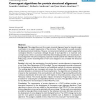Free Online Productivity Tools
i2Speak
i2Symbol
i2OCR
iTex2Img
iWeb2Print
iWeb2Shot
i2Type
iPdf2Split
iPdf2Merge
i2Bopomofo
i2Arabic
i2Style
i2Image
i2PDF
iLatex2Rtf
Sci2ools
BMCBI
2007
2007
Convergent algorithms for protein structural alignment
Background: Many algorithms exist for protein structural alignment, based on internal protein coordinates or on explicit superposition of the structures. These methods are usually successful for detecting structural similarities. However, current practical methods are seldom supported by convergence theories. In particular, although the goal of each algorithm is to maximize some scoring function, there is no practical method that theoretically guarantees score maximization. A practical algorithm with solid convergence properties would be useful for the refinement of protein folding maps, and for the development of new scores designed to be correlated with functional similarity. Results: In this work, the maximization of scoring functions in protein alignment is interpreted as a Low Order Value Optimization (LOVO) problem. The new interpretation provides a framework for the development of algorithms based on well established methods of continuous optimization. The resulting algorithms ...
Algorithms | BMCBI 2007 | Protein | Scoring Function |
| Added | 08 Dec 2010 |
| Updated | 08 Dec 2010 |
| Type | Journal |
| Year | 2007 |
| Where | BMCBI |
| Authors | Leandro Martínez, Roberto Andreani, José Mario Martínez |
Comments (0)

